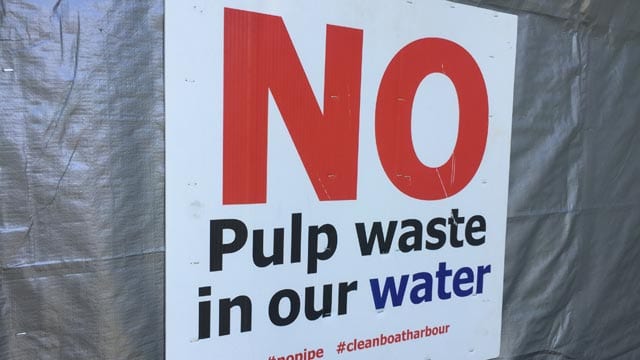
The first thing you see driving onto the property of Pictou Landing Elder Carl Thomas is a sign that reads “No Pipe” attached to the side of his porch.
Less than a half kilometre down the road is Boat Harbour – a body of water that has been the centre of a battle between the community and a pulp and paper mill for decades.
“What I’ve seen happen here at Boat harbour back in 1966, it only took a few days to wipe out this whole harbour,” Thomas said. “All the fish were dead, they were upside down. There were clams, nothing was good anymore. Our whole livelihood was taken away.”
A Lost Ecosystem

For over 50 years, Northern Pulp has been dumping toxic effluent into Boat Harbour beside Pictou Landing First Nation.
The pulp mill has been met with controversy and opposition from the community since the opening of the facility with complaints ranging from the plant’s odour to potentially-related health issues.
On a daily basis, the pulp mill pumps 80 million litres of the effluent into settling ponds, where the wastewater sits for seven to 30 days as contaminants to settle to the bottom. After a dam at the mouth of the harbour releases the water back into the strait.
“We can no longer swim back there, get our food back there, get our medicine back there, couldn’t do anything back there anymore,” said Thomas.
“It’s a dead zone.”
Water Protectors Assemble
There is now a proposal from the mill to build a subsea pipe intended to dispose of effluent into Nova Scotia’s Northumberland Strait.
Last weekend, Mi’kmaq activists and allies rallied on the beaches and in the waters of Pictou Harbour to protest the project.
Thomas said the rally was a sign of solidarity for a community whose livelihood has been crippled since the pulp mill’s construction.
“What they are proposing with that new pipeline, they are saying it’s not going to harm it. I don’t believe that,” said Thomas.
Members of Pictou Landing have expressed concern for decades about the adverse effects of the pulp mill’s toxic refuse on the environment and the community, which was disregarded until an effluent leak in 2014 pushed the company to take action.
The rupture brought much-needed attention to the condition of the lagoons, and the urgency to clean the harbour, which could cost over $130 million.

A price tag that the company is indemnified from paying due to an agreement reached in the 1960’s with the province.
“We are really concerned with what could happen if they get this proposal approved to pump their pulp effluent waste into pristine fishing grounds,” said activist Nicole MacKenzie.
“We’re still working with the fishermen to build scientific-based evidence that pumping effluent into the Northumberland Strait will be harmful to the water and marine life.”
Pictou Landing coordinated with several organizations, such as Friends of Northumberland Strait and the Northumberland Fishermen’s Association, to raise awareness about Northern Pulp’s decision to dump the potentially hazardous waste directly into the strait. Friday’s protest empowered a community whose cries for action have otherwise been ignored.
A Change in Tide
“We Indigenous people, we’re always concerned about the environment, no matter it be land or water or air. We always care,” said Thomas,
“It was good to see the chiefs from other reserves come and support the rally. It was good to see all the boats from different provinces, from different fishing areas, come down and collaborating this big rally just to make people aware, the world aware, of what is really going on. What they are really proposing.”
Good news may just be around the bend for the residents of Pictou County.
Environment Minister Catherine McKenna said on Tuesday that there may be federal intervention in the way of an environmental assessment once the plant submits their final proposal for the project in the fall.











